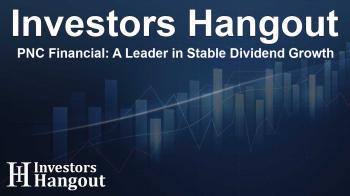PNC Financial: A Leader in Stable Dividend Growth

PNC Financial: A Leader in Dividend Stability
When it comes to choosing a bank stock, dividends are a crucial factor for many investors. Among the prominent banks, PNC Financial Services Group Inc (NASDAQ: PNC) stands out as a prime example of reliability and consistent growth in dividend payments.
PNC is ranked as the seventh largest bank in the U.S., boasting approximately $549 billion in assets. The bank has made headlines recently by increasing its dividend for the 15th consecutive year, showcasing commitment to its shareholders.
The dividend was raised by 6% to $1.70 per share, reflecting the bank's strong financial position and the board's confidence in its future strategies. William Demchak, PNC's chairman and CEO, emphasized that this increase mirrors their ongoing financial strength and robust outlook.
Understanding Dividend Metrics
Evaluating a company's dividend involves analyzing several important metrics. A key indicator is the dividend yield, which is the annual dividend payment relative to the stock price. Currently, PNC's dividend yield is around 3.26%. This yield is significantly higher than the average yield of 1.23% found within the S&P 500 index.
While other large banks such as Truist boast higher yields (4.57%) and US Bancorp (NASDAQ: USB) offers a yield of 4.17%, PNC’s longer history of consistent dividend increases and strong performance metrics make it a formidable competitor in the banking sector.
The longevity of PNC’s dividend increases is noteworthy. PNC has consistently raised its dividend amidst challenging economic conditions, even in 2020, a year when many banks were forced to cut their dividends. Only a select few banks, including JPMorgan Chase (NASDAQ: JPM), State Street (NASDAQ: STT), and others, have a comparable record.
Analyzing Payout Ratios
The payout ratio is another essential metric to consider when assessing a bank's dividend sustainability. This ratio indicates the percentage of earnings allocated to dividend payments. For PNC, the payout ratio is around 44%, which strikes a balance between rewarding shareholders and retaining enough earnings for investments and growth.
Payout ratios lower than 20% might suggest the bank is not returning enough to shareholders, while ratios exceeding 60% can imply potential overextension. PNC’s payout ratio lands comfortably within the desirable range, making it attractive to both investors seeking income and those looking for a solid growth trajectory.
Long-Term Performance Commitment
Beyond dividend yields and payout ratios, the overall stock performance is a vital consideration. PNC has shown impressive returns over the years, with a notable one-year return of 25%. Additionally, its five-year average annualized return of 14.5% and ten-year annualized return of 7.5% further illustrate its consistency as an investment.
In comparison, US Bancorp matches PNC's dividend characteristics quite well but falls short in long-term returns. Over the same period, US Bancorp reported a one-year return of 22%, with five- and ten-year annualized returns of 6.1% and 1.0%, respectively.
Another competitor worth mentioning is Fifth Third Bank, which, despite being smaller, has demonstrated strong dividend metrics. With a yield of 3.44% and a payout ratio of 43%, Fifth Third’s dividend growth trajectory also merits attention from income-focused investors.
Even though PNC may be seen as the frontrunner, Fifth Third Bank showcases similar strengths, marking the bank as another strong option for reliable dividends among local institutions.
Final Thoughts on Dividend Investing
In summary, PNC Financial Services Group Inc (NASDAQ: PNC) exemplifies what a reliable dividend stock should look like—offering consistent increases, manageable payout ratios, and solid performance metrics. As investors continue to seek opportunities within the banking sector, PNC remains a top choice for those prioritizing dependable dividend payments and long-term growth potential.
Frequently Asked Questions
What makes PNC Financial an attractive investment?
PNC is recognized for its consistent dividend growth, solid financial performance, and reasonable payout ratios, making it appealing to dividend investors.
How does PNC’s dividend yield compare to its competitors?
Currently, PNC's dividend yield stands at about 3.26%, which is competitive compared to larger banks like Truist and US Bancorp, though not the highest.
How long has PNC been raising its dividends?
PNC has raised its dividends for 15 consecutive years, demonstrating commitment to shareholder returns even during economic challenges.
What is a payout ratio and why is it important?
The payout ratio indicates the portion of earnings paid out as dividends. It helps investors determine the sustainability of the dividend.
Is PNC a good option for long-term investors?
Yes, PNC's strong performance history and increasing dividends make it a solid choice for long-term investment strategies focusing on reliable income.
About The Author
Contact Ryan Hughes privately here. Or send an email with ATTN: Ryan Hughes as the subject to contact@investorshangout.com.
About Investors Hangout
Investors Hangout is a leading online stock forum for financial discussion and learning, offering a wide range of free tools and resources. It draws in traders of all levels, who exchange market knowledge, investigate trading tactics, and keep an eye on industry developments in real time. Featuring financial articles, stock message boards, quotes, charts, company profiles, and live news updates. Through cooperative learning and a wealth of informational resources, it helps users from novices creating their first portfolios to experts honing their techniques. Join Investors Hangout today: https://investorshangout.com/
The content of this article is based on factual, publicly available information and does not represent legal, financial, or investment advice. Investors Hangout does not offer financial advice, and the author is not a licensed financial advisor. Consult a qualified advisor before making any financial or investment decisions based on this article. This article should not be considered advice to purchase, sell, or hold any securities or other investments. If any of the material provided here is inaccurate, please contact us for corrections.

